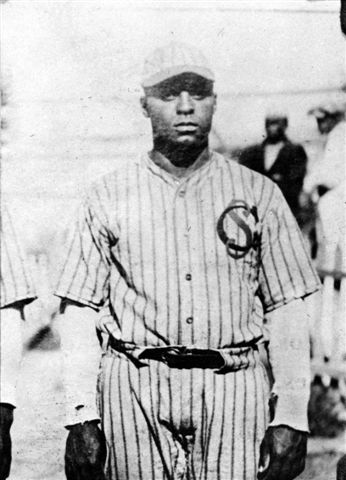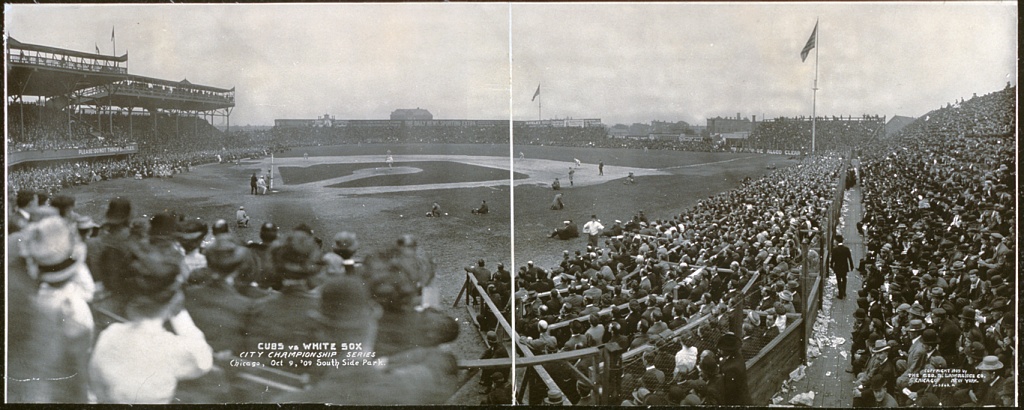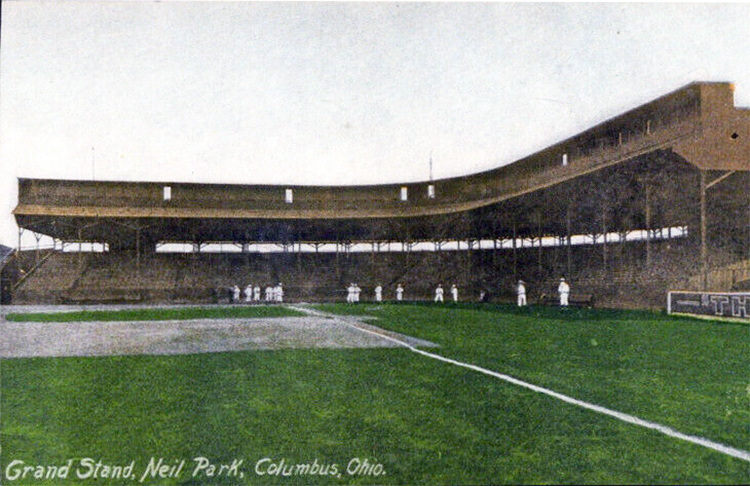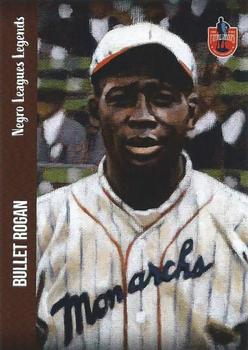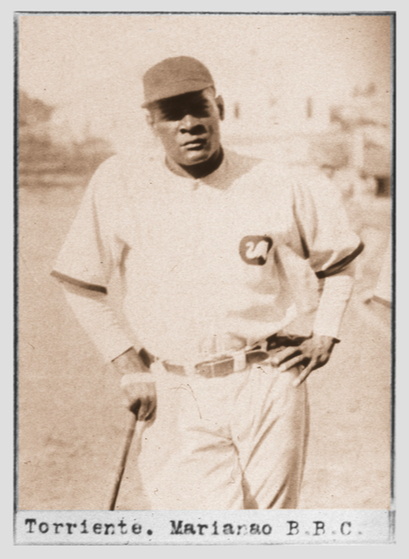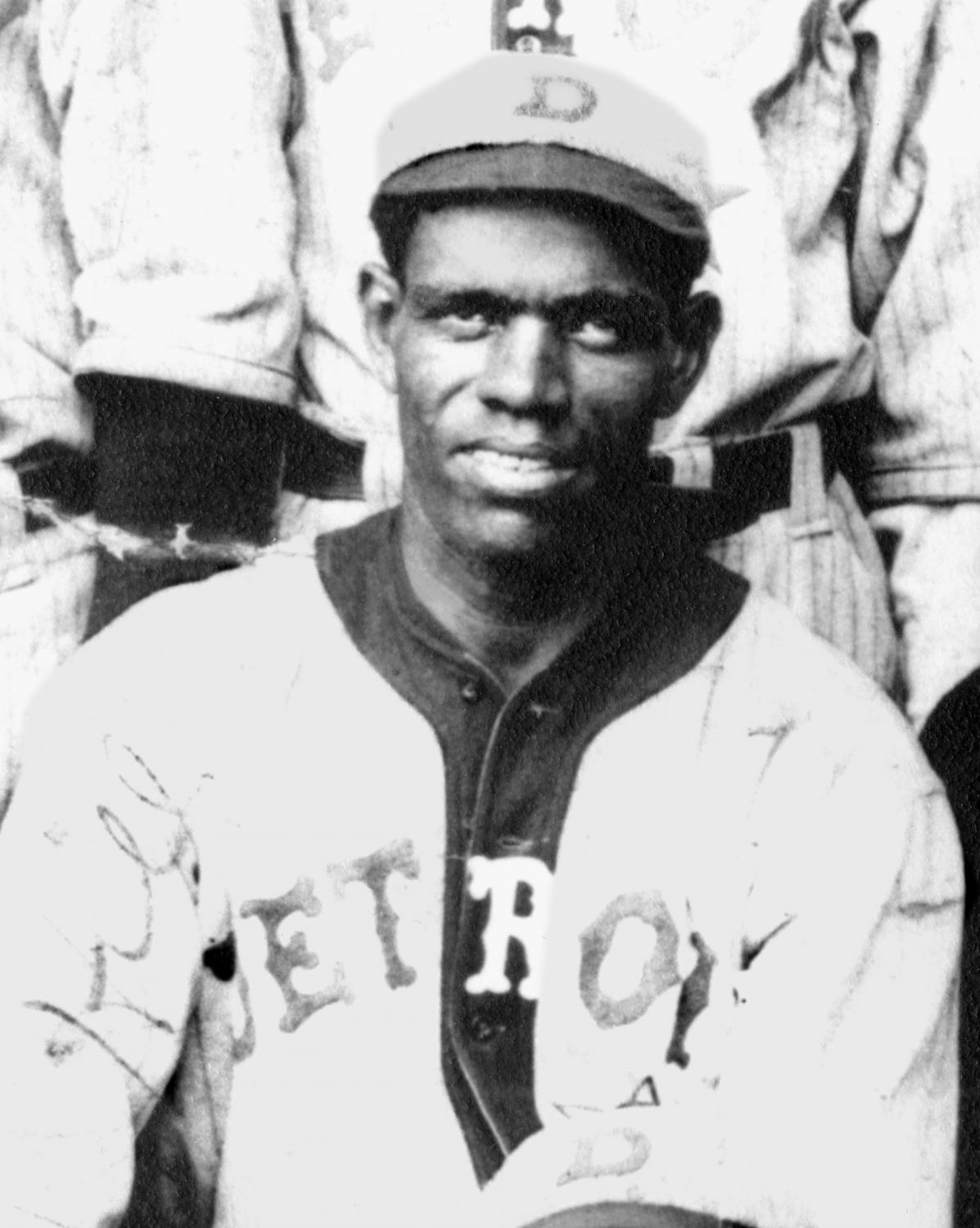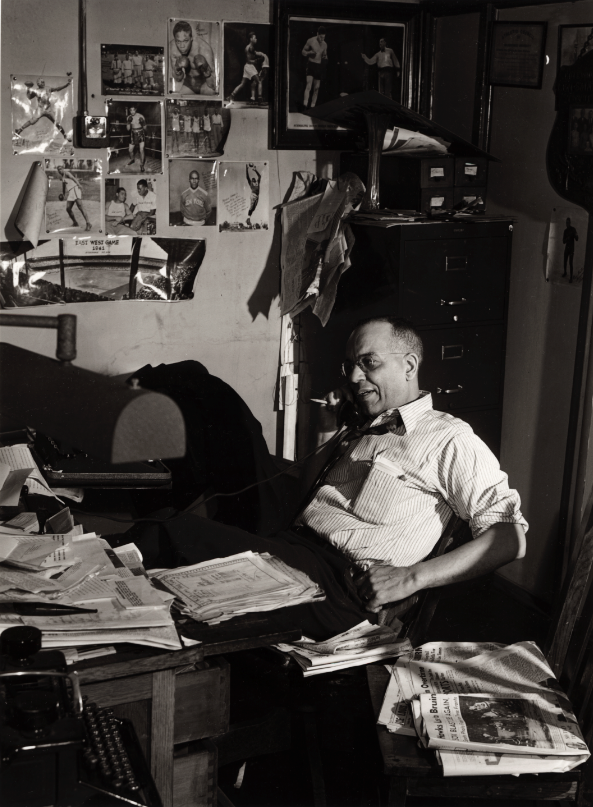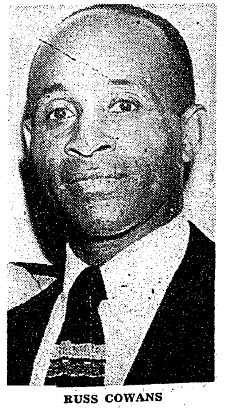The 1921 St. Louis Giants
By Kevin Johnson
The 1921 season started for the St. Louis Giants with the excitement of having the Negro Leagues’ consensus best player on the roster and ended with the team dissolving in bankruptcy. But the Negro National League franchise passed to new owners who would eventually build one of the all-time best Negro League teams.
Charles Alexander “Charlie” Mills, a Black bank messenger, took over running the St. Louis Giants, a local, all-Black amateur baseball club, in 1909. Since around 1906, the club had played mostly against all-White city teams in a vibrant St. Louis semipro baseball community. Conrad Kuebler, who owned a ballpark at Prescott and Pope Avenues, was the team owner. Sometime in the 1909 season, Mills, the club’s business manager, formed a “stock company” of 16 businessmen to increase their capital base and be able to offer higher player pay. Mills became one of the minority owners. It appears Kuebler may have sold out his share of the team before the 1911 season. Starting in 1911 and for most of the seasons through 1921, Dick Wallace managed the team. Wallace had played for the Chicago Leland Giants, and apparently through his former teammate contacts, the team was able to begin replacing the local players with better, national talent. In 1911 the Giants moved up to the “big time” in Black baseball, playing over 40 games against nationally recognized powers such as the Brooklyn Royal Giants, the Philadelphia Giants, the New York Lincoln Giants, and the Indianapolis ABCs. By 1912 and 1913 they were “city champions” of St. Louis – too strong for most of the local teams.1
Up until this point, they had been playing their home team games at two places: first at Kuebler’s Park (sometimes called Giants Park) and, by 1911, mostly at the corner of Garrison Avenue and North Market Street at Timothy Kavanaugh’s Athletic Park, which was also used for soccer games. After the 1913 season, the stock company dissolved, costing the team access to Athletic Park. Without the stock company backing, the team lost many of its best players and played a limited, much less national schedule in 1914.2
Before the 1915 season, Mills partnered a second time with Kuebler, with Kuebler providing upgrades to his park so it could become the team’s home park once again. Many of the former players returned to the team, and Mills once more began scheduling games against the top Black teams in the country. After this brief renaissance, more ownership and capital issues, ballpark issues, the East St. Louis race riots, and World War I all conspired to provide several rough years for the franchise. There is little evidence that the team even played in 1918.3
However, Mills reformed the St. Louis Giants in 1919, with new financial backing. The team moved into a new ballpark, called Giants Park (different from the previous Kuebler’s/Giants Park), at the corner of Pope and Prescott Avenues, just a block from Kuebler’s Park.4 Overall, Giants Park slightly favored hitters over pitchers. The park had a right-field fence that was approximately 20 feet closer to home plate than the left-field fence, presumably favoring left-handed hitters over right-handed ones. Although there was no official “league,” the Giants were part of an association of major Western teams that regularly played each other, which included the Chicago American Giants, the Detroit Stars, the Cuban Stars, the Dayton Marcos, and Jewell’s (Indianapolis) ABCs.
When Rube Foster brought together a group of Black team owners in 1920 to form the Negro National League, the teams he invited to join with his own Chicago American Giants team were these same teams, except that the Indianapolis team was C.I. Taylor’s ABCs (who had sat out the 1919 season), the Kansas City Monarchs (which had been reformed from the former All Nations team), and the Chicago Giants, to give the league eight teams, just like the White major leagues.
In addition to establishing the teams and playing schedules, issues Foster had to address with the other owners included player contracts and player jumping. Foster also seems to have been concerned about the league having a certain amount of parity. Charlie Mills was sick and had to send delegates to represent the Giants at the inaugural Negro National League meeting. Whether it was because he was not there to protect his interest, or because Foster had a friendship with Detroit owner Tenny Blount, or because Foster was concerned that he needed to keep Detroit competitive as a rival to Chicago, the league (Foster) made the following major player movements:
- Oscar Charleston moving from Chicago to Indianapolis, his former team and hometown.
- Jose Mendez and John Donaldson moving from Detroit to their former Kansas City location.
- Jimmie Lyons moving from the St. Louis Giants to Detroit. (Lyons had no previous connection or contract with Detroit.)
This left St. Louis without its major star, with no compensating talent coming back in return.
As might be expected, the Giants struggled to a sixth-place finish in the eight-team league in 1920. Perhaps because of the loss of Jimmie Lyons, or perhaps because Rube Foster was concerned about the financial condition of the team and wanted to boost its revenue, the Giants were assigned the contract of Oscar Charleston, the “Babe Ruth of the Negro Leagues,” for the 1921 season.
The Giants had their spring training by taking 20 potential team members to Florida in late March, then playing their way back toward St. Louis with exhibition games. Their spring training exhibition schedule was as follows:5
Ominously, Mills stated that “owing to the cold weather it has caused a heavy financial loss.”[6
Despite those premonitions, Oscar Charleston’s addition to the lineup meant optimism was high that St. Louis could be competitive with the defending champion and league flagship franchise, the Chicago American Giants. NNL teams were allowed 16 players – the Giants carried 15 active players (10 position players and 5 pitchers generally), although manager Dick Wallace could be the allowed 16th player if needed. The most common St. Louis lineup was:
- SS – Joe Hewitt (left-handed batter)
- 3B – Sam Mongin
- CF – Oscar Charleston (left-handed batter)
- RF – Charlie Blackwell (left-handed batter)
- LF – Doc Dudley (left-handed batter)
- C – Dan Kennard
- 1B – Tullie McAdoo
- 2B – Eddie Holtz
Sam Mongin left to join the Bacharach Giants the last two months of the season and was replaced by 20-year-old George Scales at third base, batting seventh, with McAdoo moving up to the number-two batting order spot.
Bench: OF/1B/3B/P – Sidney Brooks; C – Sam Bennett; SS (and manager) – Dick Wallace.
Main pitchers: Bill Drake, John Finner, Jimmy Oldham.
Other pitchers: Wayne Carr/James Field (left-hander)/Deacon Myers, Perry Hall/Herbert Smith/Otis Starks (left-hander).
Additionally, Deacon Meyers joined the team in September, replacing another rookie, James Field, who wasn’t quite good enough for this level of competition and who had previously replaced Wayne Carr as the fourth starter. Carr had jumped the team and gone east to the Brooklyn Royal Giants. Otis Starks came to St. Louis from Chicago in July to fill the fifth pitcher role that Perry Hall and then Herbert Smith had temporarily occupied. Bench player Sidney Brooks pitched in with four starts on the mound when the team was short of rested pitchers, and Oscar Charleston relieved in a few games, which were mostly blowouts.7
The Giants opened their season at home on Sunday, April 24, with the first of three games against a White professional team, the Huron Packers of the Class-D Dakota League. The Packers would finish in last place in their league. Rain was in the area, but “a few thousand followers of the game” attended. Hewitt and Mongin both went 3-for-3 with a double. In the second game, on Monday, Huron jumped out to a 6-0 in the third inning, but the Giants came back to win 12-7. Hewitt went 2-for-3. The score for the final game of the series, on Tuesday, was not reported.8
The NNL schedule rules called for the eight teams to play the other seven teams 15 times (three series of five games each), and if any team played another more than 15 times, those games were not to count in the standings.9 The first official published schedule went only through June.10 The Giants opened the NNL season on Saturday, April 30, in Kansas City against the Monarchs. A reported 2,000 fans attended the 4-2 Giants win in rainy conditions.11 The Monarchs shared their ballpark, Association Park, with the Kansas City Blues of the American Association. The park had a short right field with a 30-foot-high screen.12
On Sunday, May 1, Kansas City won 3-1 in a game whose start was delayed by rain and was played in drizzle. Bullet Rogan gave up no earned runs for the win. On Monday the Monarchs won 21-7, pounding out 26 hits.13 Oscar Charleston came in from the outfield to mop up the last four innings, and gave up four runs on nine hits. The series ended on Tuesday with a tough, 11-inning, 12-11 Giants loss.14 The Giants headed back to St. Louis for their home opener with a three-game losing streak.
The Giants opened their home season on Sunday, May 8, with a 9-0 win vs. the Chicago Giants. Bill Drake pitched the shutout for St. Louis. Catcher Dan Kennard received a deep gash on his right hand from a foul ball late in the game, requiring stitches. He was out of action until June 5.15 Catcher Charlie Hancock replaced him on the roster, but Sam Bennett became the starting catcher in Kennard’s absence. The Chicago Giants were the league’s “traveling” team, with no real home ballpark. They had finished last in the league in 1920 and would finish last again in 1921. It became obvious that they were not quite up to this level of competition and would be replaced in the NNL but continue on as a barnstorming team for many years.
Game two of the series on Monday also went to St. Louis, 6-2. The game was called after eight innings due to rain, and both the Tuesday and Wednesday games were rained out.16 On Thursday, May 12, the St. Louis Giants scored seven runs in the first inning, but the Chicago team came back, and after nine innings the score was tied 9-9. In the bottom of the 11th, Oscar Charleston hit a walk-off home run to win the game 10-9. Charleston had the first of many great days this season – he went 4-for-5 with two home runs. On Friday the teams played a doubleheader to make up for the two rained-out games. On top of having a doubleheader, pitchers John Finner and Wayne Carr were both suspended for “breaking the training rules.”17 St. Louis made it four in a row over Chicago with a 7-3 victory. In the second game, in order to save his pitching staff for the five games in a row coming up against Columbus, manager Mills started outfielder Sidney Brooks on the mound. Brooks lasted into the fourth inning, giving up four runs, then was relieved by Oscar Charleston. Charleston had what would be his best pitching performance of the season, giving up just one hit in 4⅔ innings, but the offense scored only one run in a 4-1 loss.18
Because of the makeup games on Friday, the team didn’t have much spare time, having to take a 13-hour drive to be in Columbus, Ohio, on Saturday, May 14, for the first of five games against the Columbus Buckeyes. The Buckeyes were the new team in the league, replacing the Dayton Marcos of 1920. The Buckeyes played in the second version of Neil Park, which had been used by the Detroit Tigers for two American League games in 1905, making it the first steel and concrete stadium in major-league history. With only two “real” pitchers on the trip due to the suspensions (a fifth pitcher had not yet been added to the roster), Mills again pitched outfielder Sidney Brooks. Columbus won the game, 7-3. On Sunday, May 15, Bill Drake pitched, and the Giants won 8-1. Jimmie Oldham pitched a complete-game, 13-6 Giants victory on Monday.19 Brooks had to start again Tuesday, and the Giants lost 6-4. Bill Drake pitched 3⅓ innings in relief, then came back on Wednesday as the starting pitcher. He pitched into the eighth inning Wednesday, giving up 12 runs in another loss, this time by a 15-7 score.
The team traveled back to St. Louis with a 7-7 league record. Considering that they had played the lowly Chicago Giants and the new Columbus Buckeyes; the record must have been disappointing. The team had scored 91 runs, leading the league in runs per game, but had also given up 91 runs. Great offense and poor run prevention was a recurring theme throughout the season.
On Sunday, May 22, the team hosted the Broadway Athletic Club Stars, a strong St. Louis semipro White team. The Giants won 8-6. Charlie Hancock played catcher to give Bennett a rest, and pitcher Perry Hall was given a tryout start, pitching the first three innings and giving up one run. That was good enough for him to be added to the pitching-desperate team. Pitcher Finner was back from suspension, but Carr had left the team during his suspension to pitch in Brooklyn.20
The team began a five-game series with the defending Negro National League champion Chicago American Giants on Monday, May 23. St. Louis won 13-1, with Charleston and Blackwell driving in five runs each. The second game was a different story, with Finner, pitching his first game back after his suspension, lasting for only seven batters. St. Louis lost 16-5. Finner’s short outing allowed him to come back and start the next day. In the first inning, with the bases loaded and two out, center fielder Charleston, who didn’t put on his sunglasses, lost a fly ball in the sun. Chicago scored four runs in the inning. St. Louis ended up scoring four runs in the seventh inning to tie the game 6-6, but Chicago scored one in the eighth for a 7-6 win.21 On Thursday, rain shortened the game to five innings, and St. Louis prevailed 9-3. On Friday afternoon, the largest crowd of the series turned out to see St. Louis rally for three runs in the seventh inning and win 7-6.22
After an offday on Saturday, the Giants opened a five-game series with the Cleveland Tate Stars, a new independent Black team that would take the place of Columbus in the NNL in 1922. Several major Eastern independent teams played a significant number of games against NNL teams:
- Atlantic City Bacharach Giants, 54 games
- Cleveland Tate Stars, 35 games
- Hilldale Team, 21 games
- Pittsburgh Keystones, 15 games
The Bacharach Giants, considered an associate member of the NNL, actually played more games against NNL teams than the NNL member Chicago Giants (47 games). Both Cleveland and Pittsburgh would join the NNL in 1922. Hilldale would be the driving force in founding the Eastern Colored League (ECL) in 1923; they were league champions from 1923 through 1925.
The Giants won four of five games from the Tate Stars. The most exciting game was the first one, when with the score 2-2, Dudley tripled to left field in the ninth inning, and Bennett singled him in for the walk-off win.23
The Indianapolis ABCs came to St. Louis for a scheduled five-game series that began Sunday, June 5. After they split the first two games, rain prevented the Tuesday and Wednesday games. On Thursday John Finner pitched a one-hit, 6-0 shutout. Friday was supposed to be a doubleheader to make up for the two rainouts. In the first game, Drake make it back-to-back shutouts, and Blackwell homered over the right-field fence in a 3-0 win. Rain prevented the second game from being played.24
In the original NNL schedule, St. Louis was to host the Chicago Giants June 11-15, but it appears the Chicago team may have backed out of those games. On Sunday, June 12, St. Louis hosted the White semipro Quincy (Illinois) Moose Gems, defeating them 9-3. Charleston hit two home runs. On Monday Quincy won 5-3. The Giants let 18-year-old Salvador Poree, a local Sumner High School graduate, pitch as a tryout to make the roster. He would end up starting one NNL game in August for the team.25
Without the Chicago Giant series, St. Louis had a slight midseason break in the schedule. The Giants resumed NNL games with a big five-game series at home against Kansas City, beginning Sunday, June 19. In the first game, the two pitching aces, the Monarchs’ Bullet Rogan and the Giants’ Bill Drake, were starting. Drake allowed only five hits and Tullie McAdoo had two triples and a double to lead St. Louis to a 6-1 victory.26 Monday’s game was rained out. On Tuesday Kansas City’s Dobie Moore hit one of the longest home runs ever to left field at Giants Field, and Kansas City prevailed 9-5.27 After another rainout on Wednesday, Jimmy Oldham shut out the Monarchs 6-0 on three hits. On Friday, the teams made up one of the rainout games, with Kansas City winning 6-4.28
The Giants then played a doubleheader at home on Sunday against Jewell’s ABCs, an independent Black team. St. Louis won both games, 12-6 and 6-4. Salvador Poree started the first game in his second tryout with the team, and James Field pitched the second game.29
The Columbus Buckeyes came to St. Louis for games on Wednesday and Thursday, June 29-30. These games don’t appear on any NNL schedule and seem to have been scheduled by the teams themselves, as St. Louis had open dates, and Columbus was traveling from Kansas City, with no NNL games scheduled until July 3. The Wednesday game turned out to be historic for St. Louis, as the Giants won 21-1, tying the NNL scoring record and setting the league record for the largest margin of victory. Charleston and Blackwell each had five RBIs, and Hewitt had four hits.30 In the Thursday game, Oldham pitched his second consecutive shutout as St. Louis won 8-0.31
St. Louis then went on the road for the first time in six weeks, traveling north to face the Detroit Stars and then the Chicago American Giants. Detroit was in first place in the NNL with a record of 16-3, while Chicago (17-8-2) and Kansas City (25-12) were virtually tied for second place, with St. Louis fourth at 17-12. After traveling on Friday, St. Louis opened the series on Saturday, July 1, with a 9-4 win at Mack Park in Detroit. Oscar Charleston had four hits. The Giants won 7-3 on Sunday and 11-1 on Monday.32 On Tuesday the teams played a thrilling 11-inning game, won by St. Louis 11-10 on Oscar Charleston’s second home run of the game. Detroit finally won on Wednesday, by a 7-6 score in 10 innings.33
After a couple of days off, St. Louis played the Chicago American Giants at the Gary Works Field in Gary, Indiana. Field started on the mound and was hit hard, with St. Louis losing 16-4. Sunday was a doubleheader at Schorling Park in Chicago. Chicago took the first game 2-0 and the second game 6-3.34 Both teams then boarded a train to play three games in St. Louis.
On Monday, July 11, St. Louis won 10-3, with Charleston hitting two home runs. Tuesday’s game saw Charleston rap out four hits and score four runs. However, it took a bases-clearing pinch-hit double by Brooks in the eighth to secure a 10-7 St. Louis victory. In Wednesday’s game, Blackwell got four hits and pitcher Oldham recorded 10 strikeouts, but again it took some late-game heroics for St. Louis to win, as Dudley singled home Charleston in the seventh inning with the winning run.35
The Giants were off again until Sunday, July 17, when they opened a five-game series against Detroit. St. Louis had moved ahead of fading Detroit and into third place, just a few games behind Kansas City and Chicago, who were practically tied for first. The Stars took the first game, 12-3. On Monday St. Louis won 5-0 as Finner threw a shutout, helped by Blackwell throwing out two runners at third base. On Tuesday St. Louis jumped ahead, then held on for a 6-5 victory. Wednesday’s game was won 14-9 by Detroit, with veteran Pete Hill going 5-for-6.36 The final game of the series, on Thursday, saw Charleston get four hits, but it wasn’t enough; Detroit prevailed, 3-1.37
After two offdays, the Giants played the Cuban Stars for the first time in the season on Sunday, July 24. The Stars annually brought their team from Cuba, playing their “winter” season in the US Negro Leagues, usually as a traveling team. For 1921, however, they played “home” games at Redland Field (later called Crosley Field) in Cincinnati. In a rare low-scoring game at Giants Park, St. Louis won the first game, 3-1, with Finner pitching, on a two-run single in the bottom of the seventh inning by Kennard. Monday saw the Cuban team score three runs in the top of the first, but from there it was all St. Louis, with a final score of 9-3. For Tuesday’s game, pitcher Otis Starks, who had been released by the Chicago American Giants, made his debut with St. Louis. St. Louis trailed 4-2 entering the bottom of the ninth, but scored only one run after Charleston led off with a double and Blackwell followed with a triple.38
The final game, on Thursday, was a wild one. The Cubans’ Valentín Dreke went 4-for-6 with a double, a triple, three runs scored, and three RBIs, and Bienvenido Jiménez went 3-for-6 with a triple and a home run. For St. Louis, Sam Mongin was 3-for-3 with a double, a triple, and three RBIs. Doc Dudley was 3-for-4 with a triple and three RBIs. Joe Hewitt was 3-for-6 with a double and four stolen bases. St. Louis prevailed 14-12.39
In spite of the successful series, there were ominous legal proceedings off the field. The Giants had been sued in 1920 for $3,360 by two men who claimed they were promised money plus a transfer of the ballpark grounds lease in exchange for improvements made at the ballpark in 1919. A circuit judge now ordered the team into receivership.40 A few days later the team went to the St. Louis Court of Appeals and was granted a temporary block of the receivership until September 12.41
Back on the field after two offdays, the team opened a series at home vs. the lowly Chicago Giants starting Sunday, July 31. St. Louis now had almost caught the Chicago American Giants in the standings. St. Louis won the Sunday game 8-5. Joe Hewitt had four hits, and Blackwell had a double and two triples.42 St. Louis also took the Monday game, 12-7. Tullie McAdoo was the hitting star, going 2-for-3 with a triple, a walk, and three RBIs.43 Charleston missed Monday’s and Tuesday’s games after his sister died. Tuesday’s game was tied 3-3 until the 13th inning, when rains came. A big event, the Shriners Parade, was scheduled for Wednesday, so the Wednesday game time had been moved back to a 4 P.M. start. However, the scheduled start of the parade was pushed back, causing the game to be canceled.44
The team was off on Thursday and Friday, traveling to Chicago for a two-game series with the Chicago American Giants. On Saturday, August 13, Chicago won 8-3.45 On Sunday, each team’s ace pitcher, Dave Brown for Chicago and Bill Drake for St. Louis, in front of an overflow crowd, combined for a scoreless duel until the bottom of the eighth inning, when Cristóbal Torriente led off the inning with a single to left. Catcher George Dixon sacrificed him to second. Torriente then stole third base. St. Louis played in for a possible squeeze play, but to no avail, as Jelly Gardner got the bunt down and shortstop Wallace was unable to make the play while Torriente sped home. In the top of the ninth, not only was the game still in doubt, but pitcher Brown had no-hit St. Louis’s mighty offense to that point. Sam Bennett pinch-hit for shortstop Wallace to open the inning, and broke up the no-hitter with a single. Instead of having Sidney Brooks pinch-hit for pitcher Drake, who was never much of a hitter, Brooks ran for the slow, 37-year-old catcher Bennett. It was obvious St. Louis was playing to bunt, but manager Wallace tried to cross up Chicago by having Drake swing away, and he promptly hit the ball right to shortstop Bobby Williams, who stepped on second base and fired to first to complete a double play. Doc Dudley kept St. Louis hopes alive with a single, but the game ended with Dudley thrown out by Dixon on a steal attempt. It was a bitter loss for St. Louis, just about dashing any hopes of finishing ahead of the American Giants in the standings.46
At this point, it almost appears any league schedule had been abandoned and that teams were scheduling games as best they could, against any opponent they could find. St. Louis now had another two-week break in the NNL schedule but stayed in Chicago to play the White semipro Logan Squares on Monday. St. Louis lost the game 4-2, and immediately headed to Topeka, Kansas, for a Tuesday-through-Thursday series with the Fort Riley Sante Fe Storehouse Cavalry Service, an all-Black military team.47 The only score reported was a 15-0 St. Louis win on Wednesday.48 The team then traveled home to St. Louis for a Sunday-through-Tuesday series with the Dayton Marcos, a team that had been in the NNL in 1920, but now was playing independently. St. Louis won all three games.49
On August 19, the California Eagle published the NNL standings as follows:50
| Team |
Wins |
Losses |
| Chicago American Giants |
34 |
16 |
| Kansas City Monarchs |
43 |
23 |
| St. Louis Giants |
32 |
20 |
| Detroit Stars |
25 |
21 |
| Indianapolis ABCs |
22 |
27 |
| Cincinnati Cuban Stars |
23 |
33 |
| Columbus Buckeyes |
20 |
37 |
| Chicago Giants |
10 |
32 |
After four more days off, St. Louis hosted the White semipro Belleville (Illinois) B’s. St. Louis won, 12-3.51
Beginning Monday, August 29, the team had a chance back at home to avenge the losses suffered in Chicago to the American Giants. Chicago jumped ahead 5-1 after two innings, but after that St. Louis dominated, winning 11-5. On Tuesday Chicago won 9-6 despite four hits and four runs scored by Dudley. Torriente had four hits for the winners.52
Wednesday’s game was the most exciting one of the series. Twenty-one-year-old Deacon Meyers was making his big-time debut on the mound, having been signed from the Birmingham Black Barons of the Negro Southern (minor) League. Chicago scored four in the first inning after Meyers walked the bases full, and five more in the second, when the St. Louis defense faltered, for a 9-0 lead. With two men out and none on in the bottom of the third inning, Charleston homered, sparking a St. Louis comeback. St. Louis scored two more runs that inning, two more in the fourth, one in the sixth inning, and four runs in the seventh inning. Chicago had managed to add one run in the fourth, so the game was tied, 10-10. Chicago manager Rube Foster used five pitchers attempting to stymie the comeback, but to no avail.
In the bottom of the ninth inning, with Jack Marshall pitching for Chicago, Marshall hit both Dudley and McAdoo, and after somehow getting past Charleston, who had already hit his second home run of the game, a three-run blast, in the seventh, walked Blackwell to load the bases. Marshall then hit Sam Bennett, too, forcing in the winning run for St. Louis. Deacon Meyers, amazingly after his poor first two innings, completed the game and was the winning pitcher.53
After a day off, the team traveled to Murphysboro, Illinois, for back-to-back games with the local town team, then started a series at home with the Montgomery Gray Sox, who had just finished in first place in the Negro Southern League.54 The Giants won the first game on Sunday, September 4, 6-2, then swept a holiday doubleheader, 2-1 and 6-2, on Monday. After a 9-3 win on Tuesday, the Giants lost 16-10 on Wednesday.55 The series wrapped up on Thursday with St. Louis winning 17-5.
After the game, the team immediately departed for Indiana to face the Indianapolis ABCs. In addition to what appears to be a planned five-game series in Indianapolis, the teams built in some additional games both before and after that series – almost a mini-barnstorming tour. The first game, on Friday, September 9, was played in Lebanon, Indiana. The ABCs won 8-5.56
The next day the teams visited Walnut Street Park in Muncie, Indiana. St. Louis prevailed 4-3. Then it was on to Indianapolis to play the regularly scheduled series, starting with a Sunday doubleheader. Indianapolis won the first game, 1-0, and St. Louis emerged victorious in the second game, 8-6.57 Monday saw the ABCs rout the Giants, 13-4. St. Louis came back Tuesday for a 5-1 victory. On Wednesday St. Louis won 16-3, with Charleston going 3-for-5 with a home run, three RBIs, and three runs scored. The ABCs took the final game in Indianapolis, 5-1.58
The teams then moved on to League Park in Fort Wayne, Indiana, for three more games. On Thursday, September 15, Indianapolis pitcher Jim Jeffries took a no-hitter into the ninth inning, but Eddie Holtz doubled to spoil it as the ABCs won 7-0.59 Friday’s game was rained out, so the teams added a makeup game to Saturday’s scheduled tilt.60 The start of the doubleheader was delayed by rain, but the teams were able to get the games in, with St. Louis winning 3-2 in the first game and 4-1 in the second one, in a game shortened to five innings.61
The team traveled to Chicago for its second doubleheader in two days. By this time the American Giants had pulled ahead of Kansas City in the standings, and had been declared league champions. In the first game, Dave Brown again shut out St. Louis, 2-0. In the second game, St. Louis ace Drake started on the mound against Chicago outfielder Torriente, but Drake was hit for six runs in the third inning . The left-handed Torriente was able to neutralize the dangerous left-handed St. Louis bats, and Chicago won the second game, 6-2.62
The team returned home for a five-day break, then started its final NNL series of the year in Kansas City on Saturday, September 24, with a 5-3 loss to the Monarchs in a seven-inning game, with 6,000 fans in attendance. A Sunday doubleheader had another estimated 6,000 fans see St. Louis win 9-7 in the first game, with Drake striking out nine batters. Kansas City came back to win the second game, 4-0, in six innings, with Bullet Rogan getting the shutout.63 Monday saw the Giants win 4-3, and then the Giants won again, 11-2, on Tuesday with Blackwell getting four hits. The teams played one additional game in Osawatomie, Kansas, on Thursday, with the Monarchs winning 8-6.64 The NNL standings are hard to determine, with no “official” standings kept by the league, but instead various Black newspapers printing standings that often conflicted. It appears that by splitting the six games with Kansas City, St. Louis finished in second place, .005 percentage points ahead of the Monarchs.
But the season wasn’t quite over yet. The previous fall, a group of St. Louis Cardinals led by Milt Stock had played a four-game series against the Giants. (They split the series.) The Cardinals barnstormers were putting another postseason schedule together, and would kick it off with six games against the Giants. All games were played at Sportsman’s Park. The Cardinals barnstormers were the starters for the regular National League season plus backup catcher Pickles Dillhoeffer and minus Rogers Hornsby. Jesse Haines, Bill Pertica, Roy Walker, and Lou North were the team’s pitchers – the Cardinals’ top pitchers, less Bill Doak. The Cardinals had finished in third place, seven games behind the New York Giants.
The first game of the series was played on Monday, October 3. Stands on the third-base line were for White fans, while Black fans were seated on the first-base line. (Normally, Black fans had to sit in the right-field pavilion seats for Cardinals and Browns games.)65 Roy Walker started for the Cardinals, while Bill Drake was on the mound for the Giants. The Giants took a 4-1 lead, but the Cardinals scored three runs in the eighth inning to tie the game. In the 11th, Lavan reached on an error, was sacrificed to second, and scored on a single by relief pitcher Pertica. Blackwell had four hits, including a home run, for the Giants.66 Tuesday’s game saw Oldham pitching against Haines. Oldham struck out eight, Charleston had a double and a home run, and the Giants won, 6-2.67
The teams took a break then played a doubleheader on Sunday, October 9. In the first game, the Cardinals scored six runs in the second inning and coasted to a 12-3 win. In the second game, the Cardinals scored four in the first, and the Giants could never catch up, resulting in a 9-6 Cardinals victory.68 The St. Louis Post-Dispatch reported that the gate receipts were seized due to a judgment for $3,710 from a suit in connection with the erection of the Giants Park grandstand.69
On Monday the Cardinals scored three runs in the first and three runs in the third. Charleston homered for the Giants, but it wasn’t enough in a 10-3 Cardinals victory.70 For Tuesday’s game the St. Louis Globe Democrat reported that the Giants failed to show up, noting that the gate receipts for Sunday had been attached, and the Giants players had not been paid.71 The St. Louis Argus reported that Giants owner Charlie Mills called off the game because of the cold weather.72
It was a rather ignominious end to the season and, as it turned out, to the franchise. The team had led the league in most offensive categories, including runs per game, OPS+, on-base percentage, slugging, and walk percentage. Charleston had been the league’s best hitter, with a 250 OPS+ in league games, and Blackwell had been the second best at 222 OPS+. Charleston had the “triple crown” of leading the league in batting average, home runs, and RBIs. Blackwell was second in average, third in home runs, and second in RBIs. Joe Hewitt led in stolen bases, and Charleston was second. But on the pitching side, the team was seventh out of eight teams in earned-run average. Drake had a good season, and Oldham and Finner had been around average, but the seven other pitchers with at least 10 innings pitched had been awful.73
In the league meetings in January 1922, the St. Louis franchise was awarded to new owners, who were to build a new ballpark.74 In February, the St. Louis Argus noted “financial difficulties arose during last season, and for a time it looked as if St. Louis would drop out and not be a member of the league this season.”75 In March, Rube Foster came to St. Louis to “straighten out the local tangle” of the former Giants team and the new franchise, and resolve the question of whether Oscar Charleston would play for St. Louis or Indianapolis.76 On March 31 the Argus noted that the new team would be named the St. Louis Stars and would have a new ballpark built in the heart of the city that would seat 10,000 fans.77 The Chicago Defender reported that Charleston was in spring practice with Indianapolis.78 Charleston and the Giants were no more in St. Louis. But the new team went on to be one of the NNL’s best teams from 1925 through the league’s demise in 1931.
Notes
1 Dr. Layton Revel, “Charles Mills,” www.cnlbr.org, accessed February 2, 2021.
2 Gary Ashwill, “A Brief and Incomplete History of St. Louis Giants Ballparks, Park I,” www.agatetype.typepad.com, accessed February 3, 2021.
3 Gary Ashwill, “A Brief and Incomplete History of St. Louis Giants Ballparks, Park I.”
4 Gary Ashwill, “Giants Park, St. Louis 1919-1922,” www.agatetype.typepad.com, accessed February 3, 2021.
5 “Giants Lose a Hard Fought Game,” St. Louis Argus, April 8, 1921: 12.
[6 “Eyes Turned Toward First Game Here by St. Louis Giants,” St. Louis Argus, April 15, 1921: 12.
7 Roster and transactions inferred from unpublished game data, courtesy of www.seamheads.com.
8 “St. Louis Giants Look Very Good in First Game,” St. Louis Argus, April 29, 1921: 12.
9 “National Negro League Far Behind Schedule,” St. Louis Argus, September 2, 1921: 12.
10 “The Official Negro National League Schedule for May and June,” St. Louis Argus, April 29, 1921: 12.
11 “Giants Break Even with the K.C. Monarchs,” St. Louis Argus, May 6, 1921: 12.
12 Philip J. Lowry, Green Cathedrals: The Ultimate Celebration of all Major League and Negro League Ballparks, Fifth Edition (Phoenix: Society for American Baseball Research, 2019).
13 “Monarchs Take Slugfest,” Chicago Defender, May 7, 1921: 11.
14 “St. Louis Ties Count in 9th Only to Lose in the 11th,” Chicago Defender, May 7, 1921: 10.
15 “St. Louis Giants Slaughter Windy City Pitchers,” St. Louis Argus, May 13, 1921: 12.
16 “St. Louis Giants Slaughter Windy City Pitchers,”
17 Finner and Carr Suspended,” St. Louis Argus, May 20, 1921: 12.
18 “St. Louis Giants Win Four Out of Five from Chicago,” St. Louis Argus, May 20, 1921: 12.
19 “Giants Win Two of First Three from Columbus,” St. Louis Argus, May 20, 1921: 12.
20 “Mills’ St. Louis Giants Beat Semi-pros, 8 to 6,” Chicago Defender, May 28, 1921: 11.
21 “Batting Averages Fatten in Giants Chicago A. Series,” St. Louis Argus, May 27, 1921: 12.
22 John J. Eschbacher, “Charlie Mills’ Pill Smashers Cop the Series,” Chicago Defender, June 4, 1921: 11.
23 “Cleveland No Match for the Speedy St. L. Giants,” St. Louis Argus, June 3, 1921: 12.
24 “St. Louis Giants Score 3-0 Victory Over Indianapolis,” St. Louis Star and Times, June 11, 1921: 10.
25 “Giants Break Even with Quincy Moose Club,” St. Louis Argus, June 17, 1921: 12.
26 “St. Louis Giants Beat K.C. Monarchs, 6-1,” St. Louis Globe-Democrat, June 20, 1921: 15.
27 “K.C. Monarchs Beat St. Louis Giants, 9 to 5,” St. Louis Globe-Democrat, June 22, 1921: 8.
28 “St. Louis Giants and Kay Sees in an Even Break,” Chicago Defender, July 2, 1921: 11.
29 “St. Louis Giants Take Two from Indianapolis,” St. Louis Argus, July 1, 1921: 12.
30 “Giants Trim the Columbus Buckeyes 21-1,” St. Louis Argus, July 1, 1921: 12.
31 “Giants Win Again,” St. Louis Post Dispatch, July 1, 1921: 29.
32 “Pill Smashers Win Two from Detroit Stars,” Chicago Defender, July 9, 1921: 10.
33 “Giants Make Stars Fall in Detroit,” St. Louis Argus, July 8, 1921: 12.
34 “American Giants Win 2 from St. Louis Giants,” Chicago Defender, July 16, 1921: 10.
35 “Giants Take All 3 From Rube’s Team,” St. Louis Argus, July 15, 1921: 12.
36 “Detroit Stars Split First 4 with St. Louis,” St. Louis Argus, July 22, 1921: 12.
37 “Giants Drop Final to Detroit Stars, 3 to 1,” St. Louis Globe-Democrat, July 22, 1921: 15.
38 “Giants Win Series from the Cubans,” St. Louis Argus, July 29, 1921: 12.
39 “St. Louis Giants Again Defeat Cuban Stars,” St. Louis Globe-Democrat, July 29, 1921: 16.
40 “Receiver Named for Negro Baseball Club,” St. Louis Post Dispatch, July 25, 1921: 14.
41 “St. Louis Giants Get Writ to Block Receivership,” St. Louis Star and Times, July 29, 1921: 3.
42 “St. Louis Giants Take Opener from Chicago,” St. Louis Globe-Democrat, August 1, 1921: 11.
43 “St. Louis Giants Beat Chicago Giants, 12-7,” St. Louis Globe-Democrat, August 2, 1921: 7.
44 “St. Louis Giants Win Two, Tie One with Chi. Giants,” St. Louis Argus, August 5, 1921: 12.
45 “St. Louis, 3; Am. Giants, 8,” Chicago Defender, August 20, 1921: 10.
46 “Giants Lose Sensational Game to Chi.,” St. Louis Argus, August 19, 1921: 12.
47 “Menke Makes Hit; Wins for Squares,” Kenosha (Wisconsin) Evening News, August 16, 1921: 8.
48 “Giants Defeat Storehouse,” Topeka Daily Capital, August 19, 1921: 8.
49 “Giants Take Three Exhibition Games from Dayton Marcos,” St. Louis Argus, August 26, 1921: 12.
50 “Negro Nat. League Standings,” California Eagle, August 19, 1921: 6. The league kept no “official” standings; newspapers relied on teams sending in game scores. The end result was that every paper had its own version of the standings, and no one was quite sure what the “real” league standings were. Unlike the National and American Leagues, there was no additional revenue or pay for finishing first or in the first division, so standings tended to not be viewed as important in the NNL. Unless noted, as in this instance, all standings mentioned are based on unpublished game scores courtesy of www.seamheads.com.
51 “St. Louis Giants Beat Belleville B’s, 12 to 3,” St. Louis Globe-Democrat, August 29, 1921: 6.
52 “Giants Split Season Finals with Chicago A.,” St. Louis Argus, September 2, 1921: 12.
53 “Giants Win a Thriller from Rube’s Stars Wed,” St. Louis Argus, September 2, 1921: 12.
54 “M’Boro Team to Play Five Games Next Five Days,” Daily Free Press (Carbondale, Illinois), September 2, 1921: 1.
55 “Southern Champs No Match for St. Louis Giants,” St. Louis Argus, September 9, 1921: 12.
56 “A.B.C.’s are Winners,” Lebanon (Indiana) Pioneer, September 15, 1921: 1.
57 “A.’s Divide with St. Louis Giants in Double-Header,” Indianapolis Star, September 12, 1921: 14.
58 Unpublished game data, courtesy of www.seamheads.com.
59 “Colored Leaguers in Fast Exhibition,” Fort Wayne Journal Gazette, September 16, 1921: 18.
60 “Colored Leaguers in Double-Header Today,” Fort Wayne Journal Gazette, September 17, 1921: 10.
61 “St. Louis Giants Pull Double Win Taking Series,” Fort Wayne Sentinel, September 18, 1921: 8.
62 “American Giants Beat Drake and Finner; St. Louis Drops 2,” Chicago Defender, September 24, 1921: 10.
63 “Monarchs Strengthen Hold on Second Place,” Chicago Defender, October 1, 1921: 10.
64 “Monarchs Won Here,” Osawatomie (Kansas) Graphic, October 6, 1921: 7.
65 “Cardinals and Giants Open Series Today,” St. Louis Globe-Democrat, October 3, 1921: 14.
66 “Cardinals Team Beats Giants in 11 Innings, 5 to 4,” St. Louis Globe-Democrat, October 4, 1921: 8.
67 “Giants Win Tuesday,” St. Louis Argus, October 7, 1921: 12.
68 “Giants Fall Down Before the Cardinals,” St. Louis Argus, October 14, 1921: 12.
69 “Receipts of Baseball Series Seized on an Attachment,” St. Louis Post Dispatch, October 10, 1921: 3.
70 “Cardinals Take One More from Giants, 10-3,” St. Louis Globe-Democrat, October 11, 1921: 8.
71 “Giants Fail to Show for Game with Cards,” St. Louis Globe-Democrat, October 12, 1921: 8.
72 “No Game Tuesday,” St. Louis Argus, October 14, 1921: 12.
73 https://www.seamheads.com/NegroLgs/team.php?yearID=1921&teamID=SLG&LGOrd=1. Accessed March 1, 2021.
74 “Baseball Interests Centers in Chicago,” St. Louis Argus, January 20, 1922: 12.
75 “Nat’l Negro Baseball League Magnates United for Success,” St. Louis Argus, February 17, 1922: 12.
76 “Owners of St. Louis Giants Baseball Club Quit Game,” St. Louis Argus, March 17, 1922: 12.
77 “National Negro League Baseball Club Here Is Named St. Louis Stars,” St. Louis Argus, March 31, 1921: 12.
78 “New Timber for Taylor,” Chicago Defender, April 1, 1922: 10.
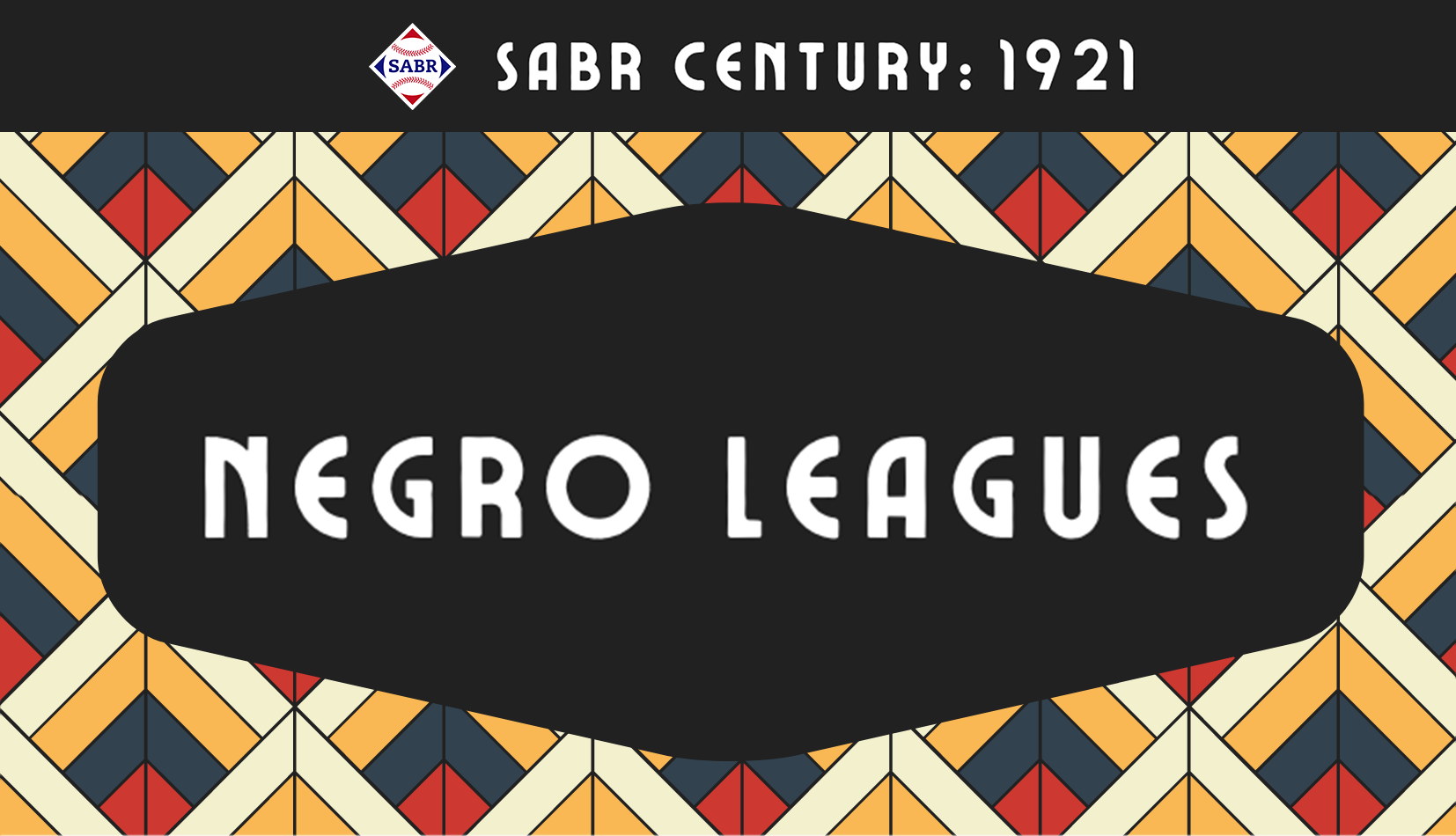
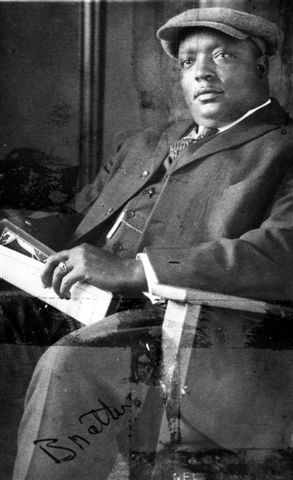 The second full season of the NNL in 1921 opened at the end of April when the Chicago Giants defeated the Columbus Buckeyes, 5-3. The league included eight teams led by Rube Foster’s 1920 champions, the Chicago American Giants. At the bottom of the league stood the other Chicago club, known as the Giants. Other cities with Negro National League teams that now enjoy major league status include Kansas City, Cincinnati, Indianapolis, St. Louis, Detroit, and Columbus.
The second full season of the NNL in 1921 opened at the end of April when the Chicago Giants defeated the Columbus Buckeyes, 5-3. The league included eight teams led by Rube Foster’s 1920 champions, the Chicago American Giants. At the bottom of the league stood the other Chicago club, known as the Giants. Other cities with Negro National League teams that now enjoy major league status include Kansas City, Cincinnati, Indianapolis, St. Louis, Detroit, and Columbus.


